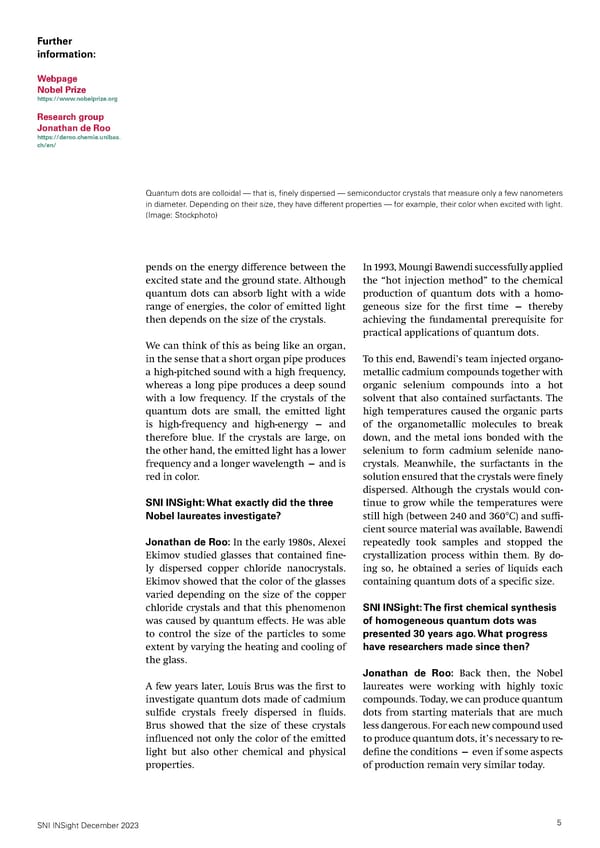Further information: Webpage Nobel Prize https://www.nobelprize.org Research group Jonathan de Roo https://deroo.chemie.unibas. ch/en/ Quantum dots are colloidal — that is, 昀椀nely dispersed — semiconductor crystals that measure only a few nanometers in diameter. Depending on their size, they have different properties — for example, their color when excited with light. (Image: Stockphoto) pends on the energy di昀昀erence between the In 1993, Moungi Bawendi successfully applied excited state and the ground state. Although the “hot injection method” to the chemical quantum dots can absorb light with a wide production of quantum dots with a homo- range of energies, the color of emitted light geneous size for the 昀椀rst time — thereby then depends on the size of the crystals. achieving the fundamental prerequisite for practical applications of quantum dots. We can think of this as being like an organ, in the sense that a short organ pipe produces To this end, Bawendi’s team injected organo- a high-pitched sound with a high frequency, metallic cadmium compounds together with whereas a long pipe produces a deep sound organic selenium compounds into a hot with a low frequency. If the crystals of the solvent that also contained surfactants. The quantum dots are small, the emitted light high temperatures caused the organic parts is high-frequency and high-energy — and of the organometallic molecules to break therefore blue. If the crystals are large, on down, and the metal ions bonded with the the other hand, the emitted light has a lower selenium to form cadmium selenide nano- frequency and a longer wavelength — and is crystals. Meanwhile, the surfactants in the red in color. solution ensured that the crystals were 昀椀nely dispersed. Although the crystals would con- SNI INSight: What exactly did the three tinue to grow while the temperatures were Nobel laureates investigate? still high (between 240 and 360°C) and su昀케- cient source material was available, Bawendi Jonathan de Roo: In the early 1980s, Alexei repeatedly took samples and stopped the Ekimov studied glasses that contained 昀椀ne- crystallization process within them. By do- ly dispersed copper chloride nanocrystals. ing so, he obtained a series of liquids each Ekimov showed that the color of the glasses containing quantum dots of a speci昀椀c size. varied depending on the size of the copper chloride crystals and that this phenomenon SNI INSight: The first chemical synthesis was caused by quantum e昀昀ects. He was able of homogeneous quantum dots was to control the size of the particles to some presented 30 years ago. What progress extent by varying the heating and cooling of have researchers made since then? the glass. Jonathan de Roo: Back then, the Nobel A few years later, Louis Brus was the 昀椀rst to laureates were working with highly toxic investigate quantum dots made of cadmium compounds. Today, we can produce quantum sul昀椀de crystals freely dispersed in 昀氀uids. dots from starting materials that are much Brus showed that the size of these crystals less dangerous. For each new compound used in昀氀uenced not only the color of the emitted to produce quantum dots, it’s necessary to re- light but also other chemical and physical de昀椀ne the conditions — even if some aspects properties. of production remain very similar today. SNI INSight December 2023 5
 SNI INSight December 2023 Page 4 Page 6
SNI INSight December 2023 Page 4 Page 6